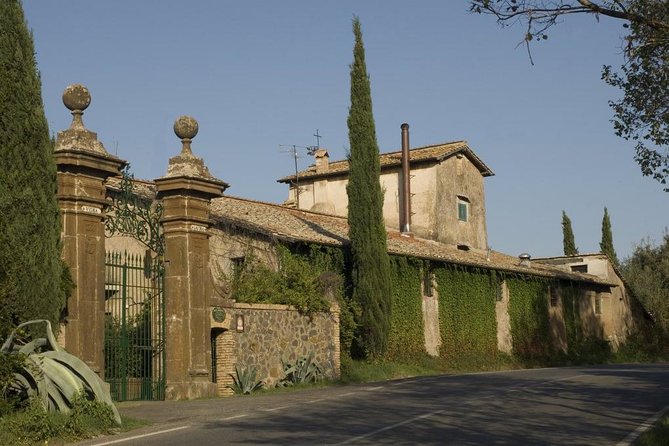On the footsteps of the “Grand Tour” in Rome: Keats, Shelley and Goethe
Rome, Italy
7 hours (Approx.)
Mobile ticket
Offered in: English and 4 more
Overview
Between the 18th and 19th centuries, the Grand Tour was a common habit for European higher class members, who desired to explore and understand other countries culture and art. Italy and Rome soon became most popular destinations for such journey and, in the years, artists like Johann Wolfgang von Goethe, Percy Shelley and John Keats were among the most known and outstanding of guests.
A private guided tour, away from the most usually visited places, will allow you to discover where these geniuses used to live and work - places that have become museums dedicated to their art. You will feel like a real Englishman or woman in Rome, sipping an exquisite cup of tea in the most ancient tea room in Italy. Finally, you will feel the peculiar, inimitable atmosphere of the place where some of these personalities have found their rest: the non-Catholic Cemetery near the Cestia Pyramid.
A private guided tour, away from the most usually visited places, will allow you to discover where these geniuses used to live and work - places that have become museums dedicated to their art. You will feel like a real Englishman or woman in Rome, sipping an exquisite cup of tea in the most ancient tea room in Italy. Finally, you will feel the peculiar, inimitable atmosphere of the place where some of these personalities have found their rest: the non-Catholic Cemetery near the Cestia Pyramid.
What's Included
Private transportation
Coffee and/or Tea
Qualified private guide
Lunch
Gratuities
Departure & Return
What To Expect
Itinerary
The square owes its name to the presence of Palazzo di Spagna, seat of the Spanish embassy for the Vatican. It is well known for the monumental stairway, well known as the "Spanish steps", built between 1721 and 1725 to connect the square to the church of Trinità dei Monti, standing on Pincio hill.
On the centre of the square stands the famous "Barcaccia" fountain, a Baroque sculpture by Pietro Bernini and his better known son, Gian Lorenzo.
Admission Ticket Free
The poet John Keats died in Rome in 1821, in a flat at the second floor of a palace located at 26, Piazza di Spagna.
In 1903, the "Keats-Shelley Memorial Association" was created to protect the building from demolition and to create a place to gather items, documents and books related to the poets' life and works.
Today, the Keats-Shelley Memorial is actually based here and also hosts a large library, focused on Romantic literature.
Duration: 1 hour
Admission Ticket Included
The only German museum based in a foreign country is hosted in the flat where Johann Wolfgang von Goethe lived, in Rome, during his journey to Italy between 1786 and 1788.
The palace is located at 18, Via del Corso; the museum is divided into a permanent part (letters, paintings, drawings and books related to Goethe's journey) and a temporary section (often dedicated to Italian/German topics and to the tradition of Grand Tours).
Duration: 1 hour
Admission Ticket Included
This tea-room was founded in 1893 by two young English ladies, who desired to provide a meeting place to the large English community in Rome. Since then, it has never ceased its activity, even during the two World Wars. The interiors style has been maintained as well and still you can find a wide and exclusive selection of English specialties, besides of more than thirty varieties of tea.
Duration: 1 hour
Admission Ticket Free
Built as a grave for Gaio Cestio Epulone between 18 and 12 B.C., the Pyramid was incorporated in the Aurelian Walls of Rome during the 4th century. Since a legend identified the pyramid with the grave of Oar, one of the city founders, the site was very popular among foreign visitors; starting from the 18th century, it was usual to bury non-Catholic people, eventually died in Rome, at the pyramid feet. In 1821, the site was officially addressed as a non-Catholic cemetery.
Admission Ticket Free
Once upon a time, the Catholic Church prohibited the burial of non-Catholics, actors and suicides in sacred ground, within the city walls. For example, the actors'cemetery lied out of Porta Pinciana, while the Jewish cemetery stood on the Aventine hill, in fronto of Circus Maximus.
This site, a leisure place for Romans in the 18th and 19th century, began to be used as a burial place from 1671, following a Vatican resolution which meant to grant protestant people died in Rome not to be inhumed together with prostitutes and outcasts.
Anyway, the cemetery was officially instituted in 1821: since then, many artists and intellectuals have been buried here: John Keats, Percy Bysshe Shelley, Antonio Gramsci, Carlo Emilio Gadda, Andrea Camilleri.
Duration: 1 hour
Admission Ticket Included
Additional Info
- Confirmation will be received within 48 hours of booking, subject to availability
- Not wheelchair accessible
- Near public transportation
- Most travelers can participate
- This is a private tour/activity. Only your group will participate
Cancellation policy
All sales are final and incur 100% cancellation penalties. Learn more about cancellations.












